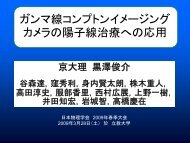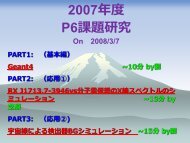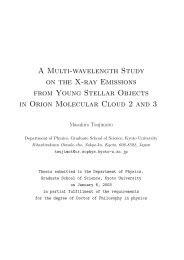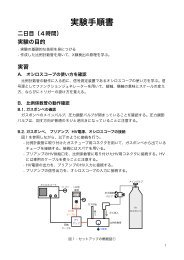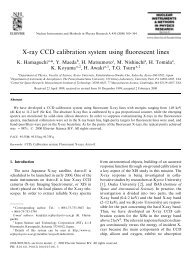110 CHAPTER 8. SYSTEMATIC STUDY OF YSO FLARESFig. 8.2.— Relation between <strong>the</strong> temperature and rise timescale <strong>of</strong> flares (kT and τ r ). Symbols are<strong>the</strong> same as Figure 7.6. The solid l<strong>in</strong>e represents <strong>the</strong> best-fit log-l<strong>in</strong>ear correlations derived withASURV (Eq.8.3). The dash-dotted and dashed l<strong>in</strong>es <strong>in</strong> (b) are constant B and L l<strong>in</strong>es derived byEqs.(C.14) and (C.15) with <strong>the</strong> assumption <strong>of</strong> n c = 10 10.48 cm −3 .8.3 Magnetic Reconnection ModelIn order to expla<strong>in</strong> <strong>the</strong> observed features <strong>of</strong> <strong>the</strong> flare parameters, we formulate τ r , τ d , and < kT >as a function <strong>of</strong> pre-flare (coronal) electronic density (n c ), half-length <strong>of</strong> <strong>the</strong> reconnected magneticloop (L) and strength <strong>of</strong> magnetic field (B), which are based on <strong>the</strong> idea <strong>of</strong> a standard magneticreconnection model (Petschek, 1964) and <strong>the</strong> balance between reconnection heat<strong>in</strong>g and conductivecool<strong>in</strong>g (Shibata & Yokoyama, 2002). For simplicity, we assume that τ d is equal to <strong>the</strong> radiativeloss timescale (τ rad ), although it would be possible that τ d is slightly larger than τ rad (see AppendixC.4). We also assume that <strong>the</strong> reconnection rate M A (ratio <strong>of</strong> <strong>the</strong> reconnection <strong>in</strong>terval and Alfvéntimescales; Eq.C.7) is 0.01, which is <strong>the</strong> mean value <strong>of</strong> M A for <strong>the</strong> solar observations (0.001–0.1,Table 2 <strong>in</strong> Isobe et al. 2002). Details <strong>of</strong> <strong>the</strong> formulae are given <strong>in</strong> Appendix C.
8.3. MAGNETIC RECONNECTION MODEL 1118.3.1 τ r vs τ d – Implication <strong>of</strong> <strong>the</strong> pre-flare densityFrom Eq.(C.12), <strong>the</strong> reconnection model predicts <strong>the</strong> positive correlation between τ r and τ d asτ d = Aτr1/2 . The slope <strong>of</strong> 1/2 shows good agreement with <strong>the</strong> observed value <strong>of</strong> 0.4±0.1 (Eq.8.2),hence supports our assumption that <strong>the</strong> decay phase is dom<strong>in</strong>ant by radiative cool<strong>in</strong>g. FromEq.(C.12), we re-estimate log(A) with <strong>the</strong> fixed slope <strong>of</strong> 1/2 to be 2.06±0.04 (<strong>the</strong> dashed l<strong>in</strong>e <strong>in</strong>Figure 8.1). We also calculate log(A) separately for each class, <strong>the</strong>n obta<strong>in</strong> 2.1±0.1, 2.0±0.1, and2.0±0.1 for class I, II, and III+III c , respectively. We see no significant difference between <strong>the</strong>classes, hence A is assumed to be <strong>the</strong> same for all sources. S<strong>in</strong>ce A is a function <strong>of</strong> n c (Eq.C.13),we can determ<strong>in</strong>e n c to ben c = 10 10.48±0.09 ( M A0.01 ) [cm−3 ]. (8.4)Consider<strong>in</strong>g <strong>the</strong> possible range <strong>of</strong> M A (0.001–0.1), this favors higher pre-flare density for YSOs(10 9 –10 12 cm −3 ) than that for <strong>the</strong> sun (∼10 9 cm −3 ). In fact, Kastner et al. (2002) derived <strong>the</strong>plasma density <strong>of</strong> a CTTS (TW Hydrae) us<strong>in</strong>g <strong>the</strong> ratio <strong>of</strong> Ne IX and O VII triplets and foundextremely high density <strong>of</strong> ∼10 13 cm −3 even <strong>in</strong> <strong>the</strong>ir quiescent phase. Hence larger n c value forYSOs than that for <strong>the</strong> sun would be common feature.8.3.2 < kT > vs τ r – Loop length and magnetic field strengthThe predicted correlations between < kT > and τ r are shown <strong>in</strong> Eqs. (C.14) and (C.15). Positive(τ r ∝< kT > 7/2 ) and negative (τ r ∝< kT > −7/6 ) correlations are expected for <strong>the</strong> constant Band L values, respectively. The dash-dotted and dashed l<strong>in</strong>es <strong>in</strong> Figure 8.2 show <strong>the</strong> constant Band L l<strong>in</strong>es, <strong>in</strong> which we uniformly assume n c = 10 10.48 cm −3 (Eq.8.4). Our observed negativecorrelation <strong>the</strong>refore predicts that flares with higher temperature is ma<strong>in</strong>ly due to larger magneticfield. However, <strong>the</strong> observed slope <strong>of</strong> −0.4±0.3 is significantly flatter than −7/6 (Eq. C.15), hence<strong>the</strong> effect <strong>of</strong> L would not be negligible. We estimate <strong>the</strong> mean B and L for each class (Table 8.2)us<strong>in</strong>g <strong>the</strong> mean values <strong>of</strong> < kT > and τ r (Figures 7.4b and 7.5a), which is summarized <strong>in</strong> Table8.2. <strong>Young</strong>er sources tend to show larger B values; <strong>the</strong> mean values <strong>of</strong> B are ∼500, 300, and 200 Gfor class I, II, and III+III c sources, respectively. This is consistent with <strong>the</strong> observed result <strong>of</strong>higher plasma temperature for younger sources. Also, <strong>the</strong> estimated values <strong>of</strong> L (10 10 –10 11 cm)suggest that L is nearly <strong>the</strong> same among <strong>the</strong>se classes, comparable to <strong>the</strong> typical radius <strong>of</strong> YSOs.These results <strong>in</strong>dicate that <strong>the</strong> flare loops for all classes are localized at <strong>the</strong> stellar surface, whichis <strong>in</strong> sharp contrast with <strong>the</strong> idea <strong>of</strong> <strong>the</strong> flares for class I sources triggered by <strong>the</strong> larger flare loopsconnect<strong>in</strong>g <strong>the</strong> star and <strong>the</strong> disk (Montmerle et al., 2000).It is conceivable that <strong>the</strong> class III flares with unusually long timescales (A-2, A-63, and BF-96)ma<strong>in</strong>ly affect <strong>the</strong> systematically lower B for class III sources. S<strong>in</strong>ce it is possible that two or more
- Page 3:
Contents1 Introduction 12 Review of
- Page 9 and 10:
List of Figures2.1 The H-R diagram
- Page 11 and 12:
LIST OF FIGURESix6.17 Light curves
- Page 13 and 14:
List of Tables3.1 Multiwavelength s
- Page 15 and 16:
Chapter 1IntroductionStar formation
- Page 17 and 18:
Chapter 2Review of Low-mass Young S
- Page 19 and 20:
2.1. EVOLUTION OF LOW-MASS STARS 5w
- Page 21 and 22:
2.2. MOLECULAR CLOUDS 72.2 Molecula
- Page 23 and 24:
2.3. X-RAY OBSERVATIONS OF LOW-MASS
- Page 25 and 26:
2.3. X-RAY OBSERVATIONS OF LOW-MASS
- Page 27:
2.3. X-RAY OBSERVATIONS OF LOW-MASS
- Page 30 and 31:
16 CHAPTER 3. REVIEW OF THE ρ OPHI
- Page 32 and 33:
18 CHAPTER 3. REVIEW OF THE ρ OPHI
- Page 34 and 35:
20 CHAPTER 3. REVIEW OF THE ρ OPHI
- Page 36 and 37:
22 CHAPTER 4. INSTRUMENTATIONrespec
- Page 38 and 39:
24 CHAPTER 4. INSTRUMENTATIONangle
- Page 40 and 41:
26 CHAPTER 4. INSTRUMENTATIONThe AC
- Page 42 and 43:
¨28 CHAPTER 4. INSTRUMENTATIONspli
- Page 44 and 45:
30 CHAPTER 4. INSTRUMENTATIONTable
- Page 46 and 47:
32 CHAPTER 5. CHANDRA OBSERVATIONS
- Page 48 and 49:
34 CHAPTER 5. CHANDRA OBSERVATIONS
- Page 50 and 51:
36 CHAPTER 5. CHANDRA OBSERVATIONS
- Page 52 and 53:
38 CHAPTER 5. CHANDRA OBSERVATIONS
- Page 54 and 55:
40 CHAPTER 5. CHANDRA OBSERVATIONS
- Page 56 and 57:
42 CHAPTER 5. CHANDRA OBSERVATIONS
- Page 58 and 59:
44 CHAPTER 5. CHANDRA OBSERVATIONS
- Page 60 and 61:
46 CHAPTER 5. CHANDRA OBSERVATIONS
- Page 62 and 63:
48 CHAPTER 5. CHANDRA OBSERVATIONS
- Page 64 and 65:
50 CHAPTER 5. CHANDRA OBSERVATIONS
- Page 66 and 67:
52 CHAPTER 5. CHANDRA OBSERVATIONS
- Page 68 and 69:
54 CHAPTER 5. CHANDRA OBSERVATIONS
- Page 70 and 71:
56 CHAPTER 5. CHANDRA OBSERVATIONS
- Page 72 and 73:
58 CHAPTER 6. INDIVIDUAL SOURCEShig
- Page 74 and 75: 60 CHAPTER 6. INDIVIDUAL SOURCESres
- Page 76 and 77: 62 CHAPTER 6. INDIVIDUAL SOURCES6.2
- Page 78 and 79: 64 CHAPTER 6. INDIVIDUAL SOURCESfla
- Page 80 and 81: 66 CHAPTER 6. INDIVIDUAL SOURCESTab
- Page 82 and 83: 68 CHAPTER 6. INDIVIDUAL SOURCESUsi
- Page 84 and 85: 70 CHAPTER 6. INDIVIDUAL SOURCESlos
- Page 86 and 87: 72 CHAPTER 6. INDIVIDUAL SOURCES6.3
- Page 88 and 89: 74 CHAPTER 6. INDIVIDUAL SOURCESdes
- Page 90 and 91: 76 CHAPTER 6. INDIVIDUAL SOURCESocc
- Page 92 and 93: 78 CHAPTER 6. INDIVIDUAL SOURCES6.4
- Page 94 and 95: 80 CHAPTER 6. INDIVIDUAL SOURCES6.4
- Page 96 and 97: 82 CHAPTER 6. INDIVIDUAL SOURCES6.5
- Page 98 and 99: 84 CHAPTER 6. INDIVIDUAL SOURCES6.5
- Page 100 and 101: 86 CHAPTER 6. INDIVIDUAL SOURCEStha
- Page 102 and 103: 88 CHAPTER 6. INDIVIDUAL SOURCES1ke
- Page 104 and 105: 90 CHAPTER 6. INDIVIDUAL SOURCESThe
- Page 106 and 107: 92 CHAPTER 6. INDIVIDUAL SOURCESFig
- Page 108 and 109: 94 CHAPTER 6. INDIVIDUAL SOURCESPra
- Page 110 and 111: 96 CHAPTER 7. OVERALL FEATURE OF X-
- Page 112 and 113: 98 CHAPTER 7. OVERALL FEATURE OF X-
- Page 114 and 115: 100 CHAPTER 7. OVERALL FEATURE OF X
- Page 116 and 117: 102 CHAPTER 7. OVERALL FEATURE OF X
- Page 118 and 119: 104 CHAPTER 7. OVERALL FEATURE OF X
- Page 121 and 122: Chapter 8Systematic Study of YSO Fl
- Page 123: 8.2. CORRELATION BETWEEN THE FLARE
- Page 127 and 128: 8.5. EFFECT OF THE QUIESCENT X-RAYS
- Page 129 and 130: 8.6. EVOLUTION OF YSOS AND THEIR FL
- Page 131 and 132: Chapter 9ConclusionWe summarize the
- Page 133 and 134: Appendix AFlare Light CurvesFig. A.
- Page 135 and 136: Fig.A.2 (Continued)121
- Page 137: Fig. A.4.— Same as Figure A.1, bu
- Page 140 and 141: 126 APPENDIX B. PHYSICAL PARAMETERS
- Page 142 and 143: 128 APPENDIX B. PHYSICAL PARAMETERS
- Page 145 and 146: Appendix CModeling of the FlareIn t
- Page 147 and 148: C.2. PREDICTED CORRELATIONS BETWEEN
- Page 149 and 150: BibliographyAgeorges, N., Eckart, A
- Page 151 and 152: BIBLIOGRAPHY 137Feigelson, E. D., &
- Page 153 and 154: BIBLIOGRAPHY 139Johnstone, D., Wils
- Page 155 and 156: BIBLIOGRAPHY 141Rutledge, R. E., Ba
- Page 157: BIBLIOGRAPHY 143Yokoyama, T. & Shib






